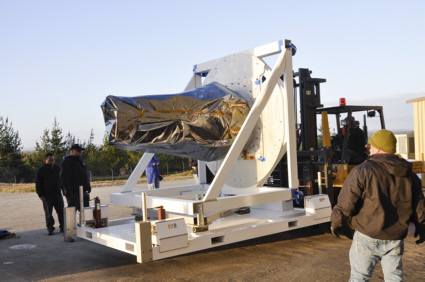

Kennedy Space Center News Release
2013 April 17

Workers unload NASA's IRIS spacecraft from a truck at the processing facility at Vandenberg where the spacecraft will be readied for launch aboard an Orbital Sciences Pegasus XL rocket. Photo credit: Vandenberg AFB/Randy Beaudoin
GREENBELT, Md. -- NASA's Interface Region Imaging Spectrograph (IRIS) satellite arrived at Vandenberg Air Force Base in California on Tuesday, April 16, to begin its final preparations for launch, currently scheduled no earlier than May 28. IRIS will improve our understanding of how heat and energy move through the deepest levels of the sun's atmosphere, thereby increasing our ability to forecast space weather.
Following final checkouts, the IRIS spacecraft will be placed inside an Orbital Sciences Pegasus rocket. Deployment of the Pegasus from the L-1011 carrier aircraft is targeted for 7:27 p.m. PDT at an altitude of 39,000 feet at a location over the Pacific Ocean about 100 miles northwest of Vandenberg AFB off the central coast of California south of Big Sur.
"IRIS will contribute significantly to our understanding of the interface region between the sun's photosphere and corona," said Joe Davila, IRIS mission scientist at NASA's Goddard Space Flight Center in Greenbelt, Md. "This region is crucial for understanding how the corona gets so hot."
IRIS carries a single instrument, a multichannel imaging spectrograph with an ultraviolet (UV) telescope that will help scientists better understand the physical processes in the sun's interface region.
"With the high-resolution images from IRIS, scientists will be able to use advanced computer models to unravel how matter, light and energy move from the sun's 6,000 Kelvin surface to its million Kelvin corona," said Eric Ianson, IRIS mission manager at NASA Goddard. "Scientists will be able to combine data from NASA's IRIS and Solar Dynamics Observatory and the NASA/JAXA Hinode missions to obtain a more comprehensive understanding of the sun's atmosphere."
IRIS is a NASA Small Explorer mission. The program provides frequent flight opportunities for world-class scientific investigations from space using innovative, streamlined and efficient management approaches within the heliophysics and astrophysics areas.
NASA's Launch Services Program at Kennedy Space Center, Fla., is responsible for launch management. Lockheed Martin's Advanced Technology Center Solar and Astrophysics Laboratory in Palo Alto, Calif., designed and built the IRIS spacecraft and instrument. NASA's Ames Research Center in Moffett Field, Calif., is responsible for mission operations and ground data systems.
For more information about the IRIS mission, visit:
Copyright © 2013, Brian Webb. All rights reserved.